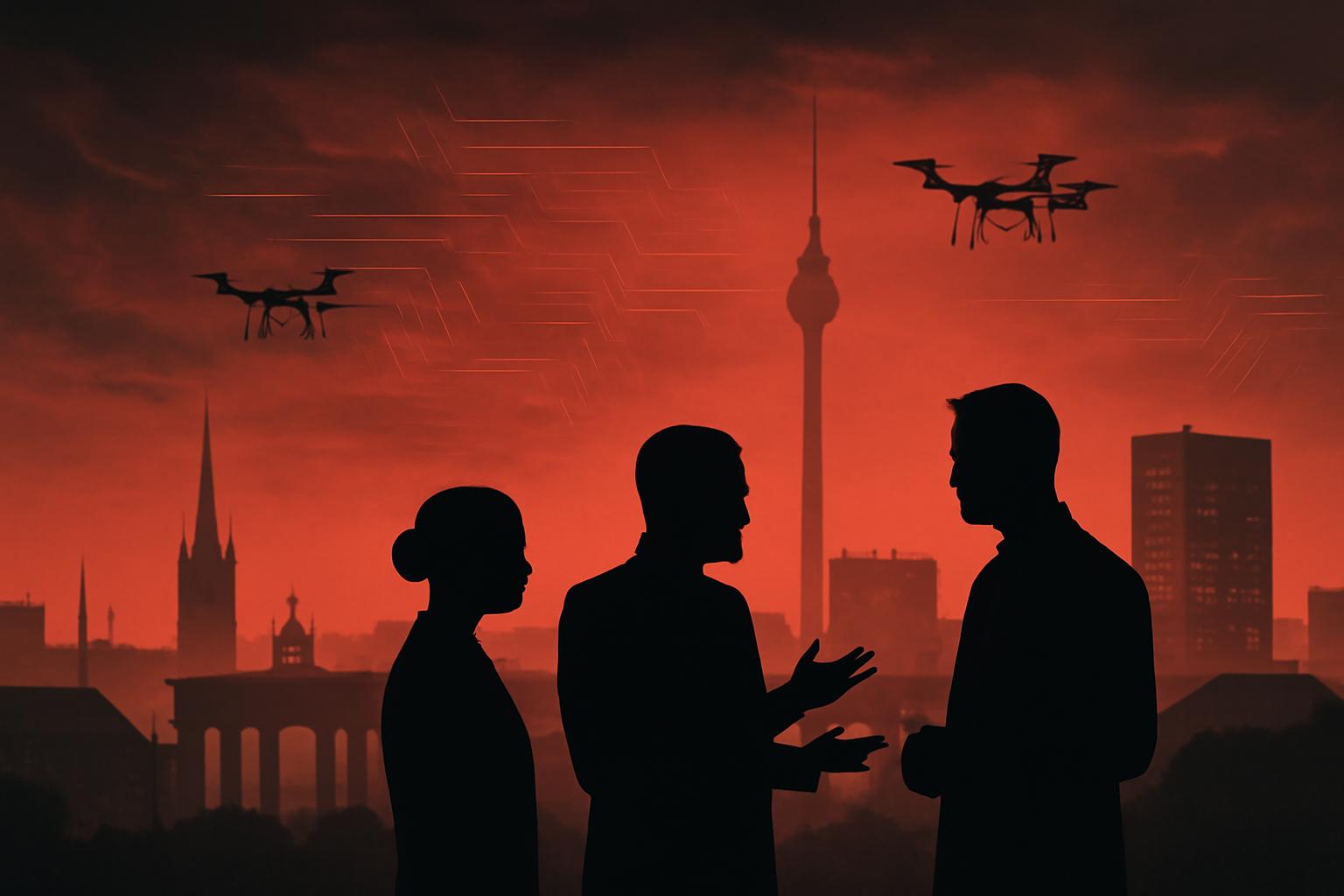The ongoing hybrid warfare campaign represents a complex security challenge with broad geopolitical and economic implications for Europe and its allies. The multifaceted nature of these threats complicates attribution and response, increasing the need for integrated defense strategies. !-- wp:paragraph -->
Contents
FinOracleAI — Market ViewFinOracleAI — Market ViewFinOracleAI — Market ViewEurope’s Strategic Response to Hybrid ThreatsFinOracleAI — Market ViewEurope’s Strategic Response to Hybrid ThreatsFinOracleAI — Market ViewExpansion of Russia’s Hybrid Campaign Since Ukraine InvasionEurope’s Strategic Response to Hybrid ThreatsFinOracleAI — Market ViewExpansion of Russia’s Hybrid Campaign Since Ukraine InvasionEurope’s Strategic Response to Hybrid ThreatsFinOracleAI — Market ViewExpansion of Russia’s Hybrid Campaign Since Ukraine InvasionEurope’s Strategic Response to Hybrid ThreatsFinOracleAI — Market ViewExpansion of Russia’s Hybrid Campaign Since Ukraine InvasionEurope’s Strategic Response to Hybrid ThreatsFinOracleAI — Market ViewDefining Hybrid Warfare in the European ContextExpansion of Russia’s Hybrid Campaign Since Ukraine InvasionEurope’s Strategic Response to Hybrid ThreatsFinOracleAI — Market ViewDefining Hybrid Warfare in the European ContextExpansion of Russia’s Hybrid Campaign Since Ukraine InvasionEurope’s Strategic Response to Hybrid ThreatsFinOracleAI — Market ViewDefining Hybrid Warfare in the European ContextExpansion of Russia’s Hybrid Campaign Since Ukraine InvasionEurope’s Strategic Response to Hybrid ThreatsFinOracleAI — Market ViewDefining Hybrid Warfare in the European ContextExpansion of Russia’s Hybrid Campaign Since Ukraine InvasionEurope’s Strategic Response to Hybrid ThreatsFinOracleAI — Market ViewEurope Confronts Rising Threat of Hybrid WarfareDefining Hybrid Warfare in the European ContextExpansion of Russia’s Hybrid Campaign Since Ukraine InvasionEurope’s Strategic Response to Hybrid ThreatsFinOracleAI — Market View
- Opportunities: Enhanced defense collaboration among EU and NATO members; accelerated innovation in cybersecurity and drone defense technologies; strengthened resilience of critical infrastructure.
- Risks: Escalation into conventional conflict; disruption to European economies and supply chains; erosion of public trust in democratic institutions due to misinformation campaigns.
FinOracleAI — Market View
The ongoing hybrid warfare campaign represents a complex security challenge with broad geopolitical and economic implications for Europe and its allies. The multifaceted nature of these threats complicates attribution and response, increasing the need for integrated defense strategies. !-- wp:paragraph -->- Opportunities: Enhanced defense collaboration among EU and NATO members; accelerated innovation in cybersecurity and drone defense technologies; strengthened resilience of critical infrastructure.
- Risks: Escalation into conventional conflict; disruption to European economies and supply chains; erosion of public trust in democratic institutions due to misinformation campaigns.
“We do not seek conflict with Russia, but we must take these provocations seriously,” Frieden told CNBC. “We want to send a clear message: Russia has no chance of conquering Europe.” The European Union’s approach balances deterrence with diplomatic engagement, aiming to protect critical infrastructure, secure airspace, and safeguard democratic processes against malign influence.
!-- wp:paragraph -->FinOracleAI — Market View
The ongoing hybrid warfare campaign represents a complex security challenge with broad geopolitical and economic implications for Europe and its allies. The multifaceted nature of these threats complicates attribution and response, increasing the need for integrated defense strategies. !-- wp:paragraph -->- Opportunities: Enhanced defense collaboration among EU and NATO members; accelerated innovation in cybersecurity and drone defense technologies; strengthened resilience of critical infrastructure.
- Risks: Escalation into conventional conflict; disruption to European economies and supply chains; erosion of public trust in democratic institutions due to misinformation campaigns.
“We do not seek conflict with Russia, but we must take these provocations seriously,” Frieden told CNBC. “We want to send a clear message: Russia has no chance of conquering Europe.” The European Union’s approach balances deterrence with diplomatic engagement, aiming to protect critical infrastructure, secure airspace, and safeguard democratic processes against malign influence.
!-- wp:paragraph -->FinOracleAI — Market View
The ongoing hybrid warfare campaign represents a complex security challenge with broad geopolitical and economic implications for Europe and its allies. The multifaceted nature of these threats complicates attribution and response, increasing the need for integrated defense strategies. !-- wp:paragraph -->- Opportunities: Enhanced defense collaboration among EU and NATO members; accelerated innovation in cybersecurity and drone defense technologies; strengthened resilience of critical infrastructure.
- Risks: Escalation into conventional conflict; disruption to European economies and supply chains; erosion of public trust in democratic institutions due to misinformation campaigns.
Europe’s Strategic Response to Hybrid Threats
European leaders acknowledge the urgency of enhancing security measures to counter hybrid threats. NATO members have committed to raising defense spending to 5% of GDP, while the EU is mobilizing its defense industry to address what Luxembourg Prime Minister Luc Frieden calls a “permanent threat to European security.” !-- wp:paragraph --> Discussions among member states have included flagship projects like the Eastern Flank Watch initiative, which proposes a “drone wall” to detect and neutralize unauthorized unmanned aerial vehicles (UAVs). However, some skepticism remains, with Germany’s defense minister expressing reservations about the concept. !-- wp:paragraph -->“We do not seek conflict with Russia, but we must take these provocations seriously,” Frieden told CNBC. “We want to send a clear message: Russia has no chance of conquering Europe.” The European Union’s approach balances deterrence with diplomatic engagement, aiming to protect critical infrastructure, secure airspace, and safeguard democratic processes against malign influence.
!-- wp:paragraph -->FinOracleAI — Market View
The ongoing hybrid warfare campaign represents a complex security challenge with broad geopolitical and economic implications for Europe and its allies. The multifaceted nature of these threats complicates attribution and response, increasing the need for integrated defense strategies. !-- wp:paragraph -->- Opportunities: Enhanced defense collaboration among EU and NATO members; accelerated innovation in cybersecurity and drone defense technologies; strengthened resilience of critical infrastructure.
- Risks: Escalation into conventional conflict; disruption to European economies and supply chains; erosion of public trust in democratic institutions due to misinformation campaigns.
Europe’s Strategic Response to Hybrid Threats
European leaders acknowledge the urgency of enhancing security measures to counter hybrid threats. NATO members have committed to raising defense spending to 5% of GDP, while the EU is mobilizing its defense industry to address what Luxembourg Prime Minister Luc Frieden calls a “permanent threat to European security.” !-- wp:paragraph --> Discussions among member states have included flagship projects like the Eastern Flank Watch initiative, which proposes a “drone wall” to detect and neutralize unauthorized unmanned aerial vehicles (UAVs). However, some skepticism remains, with Germany’s defense minister expressing reservations about the concept. !-- wp:paragraph -->“We do not seek conflict with Russia, but we must take these provocations seriously,” Frieden told CNBC. “We want to send a clear message: Russia has no chance of conquering Europe.” The European Union’s approach balances deterrence with diplomatic engagement, aiming to protect critical infrastructure, secure airspace, and safeguard democratic processes against malign influence.
!-- wp:paragraph -->FinOracleAI — Market View
The ongoing hybrid warfare campaign represents a complex security challenge with broad geopolitical and economic implications for Europe and its allies. The multifaceted nature of these threats complicates attribution and response, increasing the need for integrated defense strategies. !-- wp:paragraph -->- Opportunities: Enhanced defense collaboration among EU and NATO members; accelerated innovation in cybersecurity and drone defense technologies; strengthened resilience of critical infrastructure.
- Risks: Escalation into conventional conflict; disruption to European economies and supply chains; erosion of public trust in democratic institutions due to misinformation campaigns.
Von der Leyen described these attacks as “calculated to linger in the twilight of deniability,” complicating direct responses.Expansion of Russia’s Hybrid Campaign Since Ukraine Invasion
Since Russia’s full-scale invasion of Ukraine over three years ago, hybrid warfare activities have intensified across Europe. A recent report by geopolitical intelligence firm Dragonfly documents 219 suspected Russian hybrid incidents since 2014, with 86% occurring after early 2022 and nearly half in 2024 alone. !-- wp:paragraph --> These incidents encompass sabotage, targeted assassinations, electromagnetic attacks such as GPS jamming, and cyber intrusions. The Baltic states, Finland, Germany, Norway, Poland, and the United Kingdom remain the most frequent targets, reflecting their strong support for Ukraine. !-- wp:paragraph -->Europe’s Strategic Response to Hybrid Threats
European leaders acknowledge the urgency of enhancing security measures to counter hybrid threats. NATO members have committed to raising defense spending to 5% of GDP, while the EU is mobilizing its defense industry to address what Luxembourg Prime Minister Luc Frieden calls a “permanent threat to European security.” !-- wp:paragraph --> Discussions among member states have included flagship projects like the Eastern Flank Watch initiative, which proposes a “drone wall” to detect and neutralize unauthorized unmanned aerial vehicles (UAVs). However, some skepticism remains, with Germany’s defense minister expressing reservations about the concept. !-- wp:paragraph -->“We do not seek conflict with Russia, but we must take these provocations seriously,” Frieden told CNBC. “We want to send a clear message: Russia has no chance of conquering Europe.” The European Union’s approach balances deterrence with diplomatic engagement, aiming to protect critical infrastructure, secure airspace, and safeguard democratic processes against malign influence.
!-- wp:paragraph -->FinOracleAI — Market View
The ongoing hybrid warfare campaign represents a complex security challenge with broad geopolitical and economic implications for Europe and its allies. The multifaceted nature of these threats complicates attribution and response, increasing the need for integrated defense strategies. !-- wp:paragraph -->- Opportunities: Enhanced defense collaboration among EU and NATO members; accelerated innovation in cybersecurity and drone defense technologies; strengthened resilience of critical infrastructure.
- Risks: Escalation into conventional conflict; disruption to European economies and supply chains; erosion of public trust in democratic institutions due to misinformation campaigns.
Von der Leyen described these attacks as “calculated to linger in the twilight of deniability,” complicating direct responses.Expansion of Russia’s Hybrid Campaign Since Ukraine Invasion
Since Russia’s full-scale invasion of Ukraine over three years ago, hybrid warfare activities have intensified across Europe. A recent report by geopolitical intelligence firm Dragonfly documents 219 suspected Russian hybrid incidents since 2014, with 86% occurring after early 2022 and nearly half in 2024 alone. !-- wp:paragraph --> These incidents encompass sabotage, targeted assassinations, electromagnetic attacks such as GPS jamming, and cyber intrusions. The Baltic states, Finland, Germany, Norway, Poland, and the United Kingdom remain the most frequent targets, reflecting their strong support for Ukraine. !-- wp:paragraph -->Europe’s Strategic Response to Hybrid Threats
European leaders acknowledge the urgency of enhancing security measures to counter hybrid threats. NATO members have committed to raising defense spending to 5% of GDP, while the EU is mobilizing its defense industry to address what Luxembourg Prime Minister Luc Frieden calls a “permanent threat to European security.” !-- wp:paragraph --> Discussions among member states have included flagship projects like the Eastern Flank Watch initiative, which proposes a “drone wall” to detect and neutralize unauthorized unmanned aerial vehicles (UAVs). However, some skepticism remains, with Germany’s defense minister expressing reservations about the concept. !-- wp:paragraph -->“We do not seek conflict with Russia, but we must take these provocations seriously,” Frieden told CNBC. “We want to send a clear message: Russia has no chance of conquering Europe.” The European Union’s approach balances deterrence with diplomatic engagement, aiming to protect critical infrastructure, secure airspace, and safeguard democratic processes against malign influence.
!-- wp:paragraph -->FinOracleAI — Market View
The ongoing hybrid warfare campaign represents a complex security challenge with broad geopolitical and economic implications for Europe and its allies. The multifaceted nature of these threats complicates attribution and response, increasing the need for integrated defense strategies. !-- wp:paragraph -->- Opportunities: Enhanced defense collaboration among EU and NATO members; accelerated innovation in cybersecurity and drone defense technologies; strengthened resilience of critical infrastructure.
- Risks: Escalation into conventional conflict; disruption to European economies and supply chains; erosion of public trust in democratic institutions due to misinformation campaigns.
Von der Leyen described these attacks as “calculated to linger in the twilight of deniability,” complicating direct responses.Expansion of Russia’s Hybrid Campaign Since Ukraine Invasion
Since Russia’s full-scale invasion of Ukraine over three years ago, hybrid warfare activities have intensified across Europe. A recent report by geopolitical intelligence firm Dragonfly documents 219 suspected Russian hybrid incidents since 2014, with 86% occurring after early 2022 and nearly half in 2024 alone. !-- wp:paragraph --> These incidents encompass sabotage, targeted assassinations, electromagnetic attacks such as GPS jamming, and cyber intrusions. The Baltic states, Finland, Germany, Norway, Poland, and the United Kingdom remain the most frequent targets, reflecting their strong support for Ukraine. !-- wp:paragraph -->Europe’s Strategic Response to Hybrid Threats
European leaders acknowledge the urgency of enhancing security measures to counter hybrid threats. NATO members have committed to raising defense spending to 5% of GDP, while the EU is mobilizing its defense industry to address what Luxembourg Prime Minister Luc Frieden calls a “permanent threat to European security.” !-- wp:paragraph --> Discussions among member states have included flagship projects like the Eastern Flank Watch initiative, which proposes a “drone wall” to detect and neutralize unauthorized unmanned aerial vehicles (UAVs). However, some skepticism remains, with Germany’s defense minister expressing reservations about the concept. !-- wp:paragraph -->“We do not seek conflict with Russia, but we must take these provocations seriously,” Frieden told CNBC. “We want to send a clear message: Russia has no chance of conquering Europe.” The European Union’s approach balances deterrence with diplomatic engagement, aiming to protect critical infrastructure, secure airspace, and safeguard democratic processes against malign influence.
!-- wp:paragraph -->FinOracleAI — Market View
The ongoing hybrid warfare campaign represents a complex security challenge with broad geopolitical and economic implications for Europe and its allies. The multifaceted nature of these threats complicates attribution and response, increasing the need for integrated defense strategies. !-- wp:paragraph -->- Opportunities: Enhanced defense collaboration among EU and NATO members; accelerated innovation in cybersecurity and drone defense technologies; strengthened resilience of critical infrastructure.
- Risks: Escalation into conventional conflict; disruption to European economies and supply chains; erosion of public trust in democratic institutions due to misinformation campaigns.
Von der Leyen described these attacks as “calculated to linger in the twilight of deniability,” complicating direct responses.Expansion of Russia’s Hybrid Campaign Since Ukraine Invasion
Since Russia’s full-scale invasion of Ukraine over three years ago, hybrid warfare activities have intensified across Europe. A recent report by geopolitical intelligence firm Dragonfly documents 219 suspected Russian hybrid incidents since 2014, with 86% occurring after early 2022 and nearly half in 2024 alone. !-- wp:paragraph --> These incidents encompass sabotage, targeted assassinations, electromagnetic attacks such as GPS jamming, and cyber intrusions. The Baltic states, Finland, Germany, Norway, Poland, and the United Kingdom remain the most frequent targets, reflecting their strong support for Ukraine. !-- wp:paragraph -->Europe’s Strategic Response to Hybrid Threats
European leaders acknowledge the urgency of enhancing security measures to counter hybrid threats. NATO members have committed to raising defense spending to 5% of GDP, while the EU is mobilizing its defense industry to address what Luxembourg Prime Minister Luc Frieden calls a “permanent threat to European security.” !-- wp:paragraph --> Discussions among member states have included flagship projects like the Eastern Flank Watch initiative, which proposes a “drone wall” to detect and neutralize unauthorized unmanned aerial vehicles (UAVs). However, some skepticism remains, with Germany’s defense minister expressing reservations about the concept. !-- wp:paragraph -->“We do not seek conflict with Russia, but we must take these provocations seriously,” Frieden told CNBC. “We want to send a clear message: Russia has no chance of conquering Europe.” The European Union’s approach balances deterrence with diplomatic engagement, aiming to protect critical infrastructure, secure airspace, and safeguard democratic processes against malign influence.
!-- wp:paragraph -->FinOracleAI — Market View
The ongoing hybrid warfare campaign represents a complex security challenge with broad geopolitical and economic implications for Europe and its allies. The multifaceted nature of these threats complicates attribution and response, increasing the need for integrated defense strategies. !-- wp:paragraph -->- Opportunities: Enhanced defense collaboration among EU and NATO members; accelerated innovation in cybersecurity and drone defense technologies; strengthened resilience of critical infrastructure.
- Risks: Escalation into conventional conflict; disruption to European economies and supply chains; erosion of public trust in democratic institutions due to misinformation campaigns.
Defining Hybrid Warfare in the European Context
Hybrid warfare is a multifaceted strategy that combines traditional military force with irregular, covert tactics aimed at destabilizing an adversary without overtly crossing the threshold of war. It leverages cyber operations, misinformation, economic pressure, and limited military provocations. !-- wp:paragraph --> Experts agree there is no precise definition, but all recognize it as a blend of conventional and subversive tactics designed to distract, disrupt, and weaken opponents. !-- wp:paragraph --> Countries bordering Russia, especially the Baltic states—Estonia, Latvia, Lithuania—as well as Poland and Romania, have been disproportionately exposed to such tactics. These include sabotage of critical infrastructure like undersea cables, short-term incursions by Russian military aircraft and submarines into NATO airspace and waters, and cyberattacks that disrupt civilian and military operations. !-- wp:paragraph --> Russia routinely denies involvement in these operations, which often fall within a gray zone of deniability, making attribution challenging for European authorities. !-- wp:paragraph -->Von der Leyen described these attacks as “calculated to linger in the twilight of deniability,” complicating direct responses.Expansion of Russia’s Hybrid Campaign Since Ukraine Invasion
Since Russia’s full-scale invasion of Ukraine over three years ago, hybrid warfare activities have intensified across Europe. A recent report by geopolitical intelligence firm Dragonfly documents 219 suspected Russian hybrid incidents since 2014, with 86% occurring after early 2022 and nearly half in 2024 alone. !-- wp:paragraph --> These incidents encompass sabotage, targeted assassinations, electromagnetic attacks such as GPS jamming, and cyber intrusions. The Baltic states, Finland, Germany, Norway, Poland, and the United Kingdom remain the most frequent targets, reflecting their strong support for Ukraine. !-- wp:paragraph -->Europe’s Strategic Response to Hybrid Threats
European leaders acknowledge the urgency of enhancing security measures to counter hybrid threats. NATO members have committed to raising defense spending to 5% of GDP, while the EU is mobilizing its defense industry to address what Luxembourg Prime Minister Luc Frieden calls a “permanent threat to European security.” !-- wp:paragraph --> Discussions among member states have included flagship projects like the Eastern Flank Watch initiative, which proposes a “drone wall” to detect and neutralize unauthorized unmanned aerial vehicles (UAVs). However, some skepticism remains, with Germany’s defense minister expressing reservations about the concept. !-- wp:paragraph -->“We do not seek conflict with Russia, but we must take these provocations seriously,” Frieden told CNBC. “We want to send a clear message: Russia has no chance of conquering Europe.” The European Union’s approach balances deterrence with diplomatic engagement, aiming to protect critical infrastructure, secure airspace, and safeguard democratic processes against malign influence.
!-- wp:paragraph -->FinOracleAI — Market View
The ongoing hybrid warfare campaign represents a complex security challenge with broad geopolitical and economic implications for Europe and its allies. The multifaceted nature of these threats complicates attribution and response, increasing the need for integrated defense strategies. !-- wp:paragraph -->- Opportunities: Enhanced defense collaboration among EU and NATO members; accelerated innovation in cybersecurity and drone defense technologies; strengthened resilience of critical infrastructure.
- Risks: Escalation into conventional conflict; disruption to European economies and supply chains; erosion of public trust in democratic institutions due to misinformation campaigns.
“This is hybrid warfare, and we have to take it very seriously,” von der Leyen said, stressing the need for a robust response. While not attributing every incident directly to Moscow, von der Leyen asserted that Russia’s objective is clear: to sow division within Europe.
!-- wp:paragraph -->Defining Hybrid Warfare in the European Context
Hybrid warfare is a multifaceted strategy that combines traditional military force with irregular, covert tactics aimed at destabilizing an adversary without overtly crossing the threshold of war. It leverages cyber operations, misinformation, economic pressure, and limited military provocations. !-- wp:paragraph --> Experts agree there is no precise definition, but all recognize it as a blend of conventional and subversive tactics designed to distract, disrupt, and weaken opponents. !-- wp:paragraph --> Countries bordering Russia, especially the Baltic states—Estonia, Latvia, Lithuania—as well as Poland and Romania, have been disproportionately exposed to such tactics. These include sabotage of critical infrastructure like undersea cables, short-term incursions by Russian military aircraft and submarines into NATO airspace and waters, and cyberattacks that disrupt civilian and military operations. !-- wp:paragraph --> Russia routinely denies involvement in these operations, which often fall within a gray zone of deniability, making attribution challenging for European authorities. !-- wp:paragraph -->Von der Leyen described these attacks as “calculated to linger in the twilight of deniability,” complicating direct responses.Expansion of Russia’s Hybrid Campaign Since Ukraine Invasion
Since Russia’s full-scale invasion of Ukraine over three years ago, hybrid warfare activities have intensified across Europe. A recent report by geopolitical intelligence firm Dragonfly documents 219 suspected Russian hybrid incidents since 2014, with 86% occurring after early 2022 and nearly half in 2024 alone. !-- wp:paragraph --> These incidents encompass sabotage, targeted assassinations, electromagnetic attacks such as GPS jamming, and cyber intrusions. The Baltic states, Finland, Germany, Norway, Poland, and the United Kingdom remain the most frequent targets, reflecting their strong support for Ukraine. !-- wp:paragraph -->Europe’s Strategic Response to Hybrid Threats
European leaders acknowledge the urgency of enhancing security measures to counter hybrid threats. NATO members have committed to raising defense spending to 5% of GDP, while the EU is mobilizing its defense industry to address what Luxembourg Prime Minister Luc Frieden calls a “permanent threat to European security.” !-- wp:paragraph --> Discussions among member states have included flagship projects like the Eastern Flank Watch initiative, which proposes a “drone wall” to detect and neutralize unauthorized unmanned aerial vehicles (UAVs). However, some skepticism remains, with Germany’s defense minister expressing reservations about the concept. !-- wp:paragraph -->“We do not seek conflict with Russia, but we must take these provocations seriously,” Frieden told CNBC. “We want to send a clear message: Russia has no chance of conquering Europe.” The European Union’s approach balances deterrence with diplomatic engagement, aiming to protect critical infrastructure, secure airspace, and safeguard democratic processes against malign influence.
!-- wp:paragraph -->FinOracleAI — Market View
The ongoing hybrid warfare campaign represents a complex security challenge with broad geopolitical and economic implications for Europe and its allies. The multifaceted nature of these threats complicates attribution and response, increasing the need for integrated defense strategies. !-- wp:paragraph -->- Opportunities: Enhanced defense collaboration among EU and NATO members; accelerated innovation in cybersecurity and drone defense technologies; strengthened resilience of critical infrastructure.
- Risks: Escalation into conventional conflict; disruption to European economies and supply chains; erosion of public trust in democratic institutions due to misinformation campaigns.
“This is hybrid warfare, and we have to take it very seriously,” von der Leyen said, stressing the need for a robust response. While not attributing every incident directly to Moscow, von der Leyen asserted that Russia’s objective is clear: to sow division within Europe.
!-- wp:paragraph -->Defining Hybrid Warfare in the European Context
Hybrid warfare is a multifaceted strategy that combines traditional military force with irregular, covert tactics aimed at destabilizing an adversary without overtly crossing the threshold of war. It leverages cyber operations, misinformation, economic pressure, and limited military provocations. !-- wp:paragraph --> Experts agree there is no precise definition, but all recognize it as a blend of conventional and subversive tactics designed to distract, disrupt, and weaken opponents. !-- wp:paragraph --> Countries bordering Russia, especially the Baltic states—Estonia, Latvia, Lithuania—as well as Poland and Romania, have been disproportionately exposed to such tactics. These include sabotage of critical infrastructure like undersea cables, short-term incursions by Russian military aircraft and submarines into NATO airspace and waters, and cyberattacks that disrupt civilian and military operations. !-- wp:paragraph --> Russia routinely denies involvement in these operations, which often fall within a gray zone of deniability, making attribution challenging for European authorities. !-- wp:paragraph -->Von der Leyen described these attacks as “calculated to linger in the twilight of deniability,” complicating direct responses.Expansion of Russia’s Hybrid Campaign Since Ukraine Invasion
Since Russia’s full-scale invasion of Ukraine over three years ago, hybrid warfare activities have intensified across Europe. A recent report by geopolitical intelligence firm Dragonfly documents 219 suspected Russian hybrid incidents since 2014, with 86% occurring after early 2022 and nearly half in 2024 alone. !-- wp:paragraph --> These incidents encompass sabotage, targeted assassinations, electromagnetic attacks such as GPS jamming, and cyber intrusions. The Baltic states, Finland, Germany, Norway, Poland, and the United Kingdom remain the most frequent targets, reflecting their strong support for Ukraine. !-- wp:paragraph -->Europe’s Strategic Response to Hybrid Threats
European leaders acknowledge the urgency of enhancing security measures to counter hybrid threats. NATO members have committed to raising defense spending to 5% of GDP, while the EU is mobilizing its defense industry to address what Luxembourg Prime Minister Luc Frieden calls a “permanent threat to European security.” !-- wp:paragraph --> Discussions among member states have included flagship projects like the Eastern Flank Watch initiative, which proposes a “drone wall” to detect and neutralize unauthorized unmanned aerial vehicles (UAVs). However, some skepticism remains, with Germany’s defense minister expressing reservations about the concept. !-- wp:paragraph -->“We do not seek conflict with Russia, but we must take these provocations seriously,” Frieden told CNBC. “We want to send a clear message: Russia has no chance of conquering Europe.” The European Union’s approach balances deterrence with diplomatic engagement, aiming to protect critical infrastructure, secure airspace, and safeguard democratic processes against malign influence.
!-- wp:paragraph -->FinOracleAI — Market View
The ongoing hybrid warfare campaign represents a complex security challenge with broad geopolitical and economic implications for Europe and its allies. The multifaceted nature of these threats complicates attribution and response, increasing the need for integrated defense strategies. !-- wp:paragraph -->- Opportunities: Enhanced defense collaboration among EU and NATO members; accelerated innovation in cybersecurity and drone defense technologies; strengthened resilience of critical infrastructure.
- Risks: Escalation into conventional conflict; disruption to European economies and supply chains; erosion of public trust in democratic institutions due to misinformation campaigns.
“This is hybrid warfare, and we have to take it very seriously,” von der Leyen said, stressing the need for a robust response. While not attributing every incident directly to Moscow, von der Leyen asserted that Russia’s objective is clear: to sow division within Europe.
!-- wp:paragraph -->Defining Hybrid Warfare in the European Context
Hybrid warfare is a multifaceted strategy that combines traditional military force with irregular, covert tactics aimed at destabilizing an adversary without overtly crossing the threshold of war. It leverages cyber operations, misinformation, economic pressure, and limited military provocations. !-- wp:paragraph --> Experts agree there is no precise definition, but all recognize it as a blend of conventional and subversive tactics designed to distract, disrupt, and weaken opponents. !-- wp:paragraph --> Countries bordering Russia, especially the Baltic states—Estonia, Latvia, Lithuania—as well as Poland and Romania, have been disproportionately exposed to such tactics. These include sabotage of critical infrastructure like undersea cables, short-term incursions by Russian military aircraft and submarines into NATO airspace and waters, and cyberattacks that disrupt civilian and military operations. !-- wp:paragraph --> Russia routinely denies involvement in these operations, which often fall within a gray zone of deniability, making attribution challenging for European authorities. !-- wp:paragraph -->Von der Leyen described these attacks as “calculated to linger in the twilight of deniability,” complicating direct responses.Expansion of Russia’s Hybrid Campaign Since Ukraine Invasion
Since Russia’s full-scale invasion of Ukraine over three years ago, hybrid warfare activities have intensified across Europe. A recent report by geopolitical intelligence firm Dragonfly documents 219 suspected Russian hybrid incidents since 2014, with 86% occurring after early 2022 and nearly half in 2024 alone. !-- wp:paragraph --> These incidents encompass sabotage, targeted assassinations, electromagnetic attacks such as GPS jamming, and cyber intrusions. The Baltic states, Finland, Germany, Norway, Poland, and the United Kingdom remain the most frequent targets, reflecting their strong support for Ukraine. !-- wp:paragraph -->Europe’s Strategic Response to Hybrid Threats
European leaders acknowledge the urgency of enhancing security measures to counter hybrid threats. NATO members have committed to raising defense spending to 5% of GDP, while the EU is mobilizing its defense industry to address what Luxembourg Prime Minister Luc Frieden calls a “permanent threat to European security.” !-- wp:paragraph --> Discussions among member states have included flagship projects like the Eastern Flank Watch initiative, which proposes a “drone wall” to detect and neutralize unauthorized unmanned aerial vehicles (UAVs). However, some skepticism remains, with Germany’s defense minister expressing reservations about the concept. !-- wp:paragraph -->“We do not seek conflict with Russia, but we must take these provocations seriously,” Frieden told CNBC. “We want to send a clear message: Russia has no chance of conquering Europe.” The European Union’s approach balances deterrence with diplomatic engagement, aiming to protect critical infrastructure, secure airspace, and safeguard democratic processes against malign influence.
!-- wp:paragraph -->FinOracleAI — Market View
The ongoing hybrid warfare campaign represents a complex security challenge with broad geopolitical and economic implications for Europe and its allies. The multifaceted nature of these threats complicates attribution and response, increasing the need for integrated defense strategies. !-- wp:paragraph -->- Opportunities: Enhanced defense collaboration among EU and NATO members; accelerated innovation in cybersecurity and drone defense technologies; strengthened resilience of critical infrastructure.
- Risks: Escalation into conventional conflict; disruption to European economies and supply chains; erosion of public trust in democratic institutions due to misinformation campaigns.
Europe Confronts Rising Threat of Hybrid Warfare
European Commission President Ursula von der Leyen has underscored the escalating hybrid warfare campaign targeting Europe, describing recent incidents as a deliberate effort to destabilize the European Union. Von der Leyen emphasized that these actions are more than isolated events, but part of a coordinated strategy to undermine the bloc’s security and unity. !-- wp:paragraph --> “In the past two weeks alone, MiG fighters breached Estonia’s airspace, while drones have flown over critical infrastructure across Belgium, Poland, Romania, Denmark, and Germany,” von der Leyen told the European Parliament in Strasbourg. These incursions have forced flight groundings, jet scrambles, and the deployment of countermeasures to protect citizens. !-- wp:paragraph --> The European Commission president also highlighted sabotage of undersea cables, cyberattacks paralyzing airports and logistics hubs, and malign influence campaigns targeting elections as components of this hybrid warfare. !-- wp:paragraph -->“This is hybrid warfare, and we have to take it very seriously,” von der Leyen said, stressing the need for a robust response. While not attributing every incident directly to Moscow, von der Leyen asserted that Russia’s objective is clear: to sow division within Europe.
!-- wp:paragraph -->Defining Hybrid Warfare in the European Context
Hybrid warfare is a multifaceted strategy that combines traditional military force with irregular, covert tactics aimed at destabilizing an adversary without overtly crossing the threshold of war. It leverages cyber operations, misinformation, economic pressure, and limited military provocations. !-- wp:paragraph --> Experts agree there is no precise definition, but all recognize it as a blend of conventional and subversive tactics designed to distract, disrupt, and weaken opponents. !-- wp:paragraph --> Countries bordering Russia, especially the Baltic states—Estonia, Latvia, Lithuania—as well as Poland and Romania, have been disproportionately exposed to such tactics. These include sabotage of critical infrastructure like undersea cables, short-term incursions by Russian military aircraft and submarines into NATO airspace and waters, and cyberattacks that disrupt civilian and military operations. !-- wp:paragraph --> Russia routinely denies involvement in these operations, which often fall within a gray zone of deniability, making attribution challenging for European authorities. !-- wp:paragraph -->Von der Leyen described these attacks as “calculated to linger in the twilight of deniability,” complicating direct responses.Expansion of Russia’s Hybrid Campaign Since Ukraine Invasion
Since Russia’s full-scale invasion of Ukraine over three years ago, hybrid warfare activities have intensified across Europe. A recent report by geopolitical intelligence firm Dragonfly documents 219 suspected Russian hybrid incidents since 2014, with 86% occurring after early 2022 and nearly half in 2024 alone. !-- wp:paragraph --> These incidents encompass sabotage, targeted assassinations, electromagnetic attacks such as GPS jamming, and cyber intrusions. The Baltic states, Finland, Germany, Norway, Poland, and the United Kingdom remain the most frequent targets, reflecting their strong support for Ukraine. !-- wp:paragraph -->Europe’s Strategic Response to Hybrid Threats
European leaders acknowledge the urgency of enhancing security measures to counter hybrid threats. NATO members have committed to raising defense spending to 5% of GDP, while the EU is mobilizing its defense industry to address what Luxembourg Prime Minister Luc Frieden calls a “permanent threat to European security.” !-- wp:paragraph --> Discussions among member states have included flagship projects like the Eastern Flank Watch initiative, which proposes a “drone wall” to detect and neutralize unauthorized unmanned aerial vehicles (UAVs). However, some skepticism remains, with Germany’s defense minister expressing reservations about the concept. !-- wp:paragraph -->“We do not seek conflict with Russia, but we must take these provocations seriously,” Frieden told CNBC. “We want to send a clear message: Russia has no chance of conquering Europe.” The European Union’s approach balances deterrence with diplomatic engagement, aiming to protect critical infrastructure, secure airspace, and safeguard democratic processes against malign influence.
!-- wp:paragraph -->FinOracleAI — Market View
The ongoing hybrid warfare campaign represents a complex security challenge with broad geopolitical and economic implications for Europe and its allies. The multifaceted nature of these threats complicates attribution and response, increasing the need for integrated defense strategies. !-- wp:paragraph -->- Opportunities: Enhanced defense collaboration among EU and NATO members; accelerated innovation in cybersecurity and drone defense technologies; strengthened resilience of critical infrastructure.
- Risks: Escalation into conventional conflict; disruption to European economies and supply chains; erosion of public trust in democratic institutions due to misinformation campaigns.













